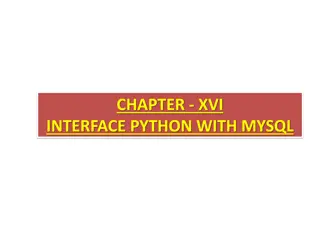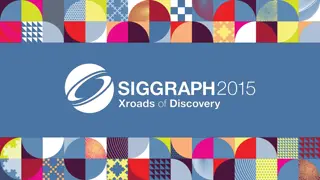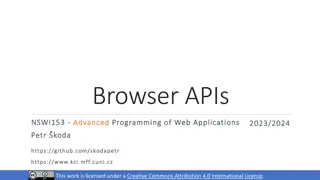Essential Features of RTC-5 Based on M5 Analysis
This document delves into the essential features of RTC-5 derived from an analysis of the existing 5GMS M5 interface. It highlights the need for clarity in RTC-5 features to avoid overlapping functionalities with WebRTC signaling, proposing updates to API descriptions to enhance understanding.
Download Presentation

Please find below an Image/Link to download the presentation.
The content on the website is provided AS IS for your information and personal use only. It may not be sold, licensed, or shared on other websites without obtaining consent from the author.If you encounter any issues during the download, it is possible that the publisher has removed the file from their server.
You are allowed to download the files provided on this website for personal or commercial use, subject to the condition that they are used lawfully. All files are the property of their respective owners.
The content on the website is provided AS IS for your information and personal use only. It may not be sold, licensed, or shared on other websites without obtaining consent from the author.
E N D
Presentation Transcript
Proposals for RTC Proposals for RTC- -5 features and APIs 5 features and APIs based on M5 analysis based on M5 analysis S4 S4- -221387 (revision of S4aR220051) 221387 (revision of S4aR220051) NTT NTT 0
Summary Summary This document tries to clarify the essential features of RTC-5 based on the analysis on the existing 5GMS s M5 interface which seems useful for designing RTC-5 interface. [Motivation] The discussion about RTC-5 has been started, but there were some concerns about the details of RTC-5 and its separation. We found that RTC-5 features (already proposed) should be checked. In CS#3 and #4, QoS control is expected to be conducted using WebRTC signalling. This may create a problem that the same feature may be performed by WebRTC signalling and RTC-5. To tackle with this overlapping/redundant problem, RTC-5 should be clarified. First, the features and APIs in TS 26.512 5GMS are extracted. Five APIs are relevant. (Slide #2, 3) The functionality of the picked-up five APIs are summarized based on the description of Clause 4 in TS 26.512. (Slide #4) Then, the applicability of the APIs in the context of RTC is discussed. (Slide #5) Finally, the already-proposed RTC-5 features and possible four APIs are examined. (Slide #6) Proposal Proposal Based on the analysis in this document, the description of RTC-5 features should be updated in GA4RTAR. API description should be included in iRTCW PD. 1
APIs of M5d (for downlink) from Media Streaming APIs of M5d (for downlink) from Media Streaming According to TS 26.512, APIs related to M5 downlink interface can be extracted: 1. Service Access Information API 2. Metrics Reporting API 3. Consumption Reporting API 4. Dynamic Policies API 5. Network Assistance API M5 related APIs are marked 5GMSd feature Abstract Relevant APIs Interface API name Clause 7.5 Content protocols discovery Used by the 5GMSd Application Provider to interrogate which content ingest protocols are supported by 5GMSd AS(s). Content is ingested, hosted and distributed by the 5GMSd AS according to a Content Hosting Configuration associated with a Provisioning Session. Content Protocols Discovery API M1d Content hosting Provisioning Sessions API Server Certificates Provisioning API Content Preparation Templates Provisioning API Content Hosting Provisioning API HTTP-pull based content ingest protocol DASH-IF push based content ingest protocol DASH [4] or 3GP [37] Service Access Information API Provisioning Sessions API Metrics Reporting Provisioning API Service Access Information API Metrics Reporting API 7.2 7.3 7.4 M1d 7.6 8.2 8.3 10 11.2 7.2 7.8 11.2 11.4 M2d M4d M5d M1d Metrics reporting The 5GMSd Client uploads metrics reports to the 5GMSd AF according to a provisioned Metrics Reporting Configuration it obtains from the Service Access Information for its Provisioning Session. The 5GMSd Client provides feedback reports on currently consumed content according to a provisioned Consumption Reporting Configuration it obtains from the Service Access Information for its Provisioning Session. The 5GMSd Client activates different traffic treatment policies selected from a set of Policy Templates configured in its Provisioning Session. The 5GMSd Client requests bit rate recommendations and delivery boosts from the 5GMSd AF. M5d Consumption reporting Provisioning Sessions API Consumption Reporting Provisioning API Service Access Information API Consumption Reporting API 7.2 7.7 11.2 11.3 M1d M5d Dynamic Policy invocation Provisioning Sessions API Policy Templates Provisioning API Service Access Information API Dynamic Policies API Service Access Information API Network Assistance API 7.2 7.9 11.2 11.5 11.2 11.6 M1d M5d Network Assistance M5d APIs for downlink Media Streaming from Table 4.2-1 TS 26.512 2
APIs of M5u (for uplink) from Media Streaming APIs of M5u (for uplink) from Media Streaming Regarding M5 uplink interface, except the consumption reporting, same APIs can be extracted. 1. Service Access Information API 2. Metrics Reporting API 3. Dynamic Policies API 4. Network Assistance API M5 related APIs are marked 5GMSu feature Abstract Relevant APIs Interface M1u API name Clause 7.5 Content protocols discovery Used by the 5GMSu Application Provider to query which content egest protocols are supported by 5GMSu AS(s). Supports manipulation by the 5GMSu AS of streaming media content uploaded by 5GMSu Client over M4u, prior to egest of the manipulated content over M2u. The 5GMSu Client uploads metrics reports to the 5GMSu AF according to a provisioned Metrics Reporting Configuration it obtains from the Service Access Information for its Provisioning Session. The 5GMSu Client activates different traffic treatment policies selected from a set of Policy Templates configured in its Provisioning Session. The 5GMSu Client requests bit rate recommendations and delivery boosts from the 5GMSu AF. Content Protocols Discovery API Content preparation M1u Content Preparation Templates Provisioning API 7.4 Metrics reporting M1u Provisioning Sessions API Metrics Reporting Provisioning API Service Access Information API Metrics Reporting API 7.2 7.8 11.2 11.4 M5u Dynamic Policy invocation M1u Provisioning Sessions API Policy Templates Provisioning API Service Access Information API Dynamic Policies API Service Access Information API Network Assistance API 7.2 7.9 11.2 11.5 11.2 11.6 M5u Network Assistance M5u APIs for uplink Media Streaming from Table 4.2-1 TS 26.512 3
M5 M5- -related related APIs summary APIs summary (NTT s interpretation) (NTT s interpretation) This table shows the extracted M5 related APIs and brief summary of them based on the description of Clause 4 in TS26.512. Service Access Information API MSH acquires the set of parameters and addresses (=entry point of media) for streaming session This information is provided by AF (or out channel via M8/5GMS-aware Apps) MSH periodically checks the update of Service Access Information MSH sends metrics to AF based on configured metric schemes. Metrics are 3GPP-defined or non-3GPP-defined (mainly used for progressive download) e.g., Average throughput, initial playout delay, buffer level MSH periodically sends consumption report according to the sample percentage value (the state of media player s media consumption amount in client terminal, which is related to buffer management and fetching fragments of a static media content such as progressive download) Service Access Information indicates the use of Consumption reporting by AF MSH requests AF that a Policy Template is applied to an application flow A Policy Template includes QoS properties and charging treatments A Policy Template is used with Service provisioning ID, Service Data Flow information to invoke N33/N5 by AF 5GMS Client requests QoS from PCF via AF (delivery boost) 5GMS Client receives bitrate recommendation (for selecting media resolution). Metrics Reporting API Consumption Reporting API Dynamic Policies API Network Assistance API 4
Evaluation Evaluation - - Applicability of M5 APIs to RTC Applicability of M5 APIs to RTC- -5 5 The table below evaluates M5 APIs on its applicability to RTC-5. Consumption Reporting API is unique to media streaming and is not necessary for real-time communication. Service Access Information API, Metrics Reporting API, Dynamic Policies API, and Network Assistance API seem to be useful for RTP/Data channel media transmission, which can be diverted to RTC-5. (some modification may be needed) Service Access Information API This API is useful for a client terminal to get information about a specific VR/AR conference and the connection to it (e.g., media server s IP address and media format). However, this API should be optional when M8-like service-specific signalling is available for this purpose. This API is useful in RTC-5, but specific metrics should be clarified for RTC. Example RTC metrics are for AF to estimate the state of a terminal or network congestion between a terminal and AF. iRTC services are not defined to use progressive download like media streaming but use RTP and Data Channel. This API does not seem useful because real-time media is consumed almost immediately and does not need to indicate the position of media playback. This API is useful in RTC-5 to request QoS and charging policy to AF at session setup. Flexibility of template for RTC should be clarified. This API is useful in RTC-5 to request temporary bandwidth increase (like delivery boost). Also, bitrate recommendation feature is useful for terminals to get supplemental network information which cannot be measured by terminals. (Based on the information, terminal may trigger the adjustment of bitrate by selecting media resolution.) Metrics Reporting API Consumption Reporting API Dynamic Policies API Network Assistance API 5
Clarification of RTC Clarification of RTC- -5 based on M5 evaluation 5 based on M5 evaluation S4a220028 S4a220028 says 0. Some explanations about configuration information (the paragraph may need further enhancements) 1. MSH informs the MSH (mistake of AF?) about a WebRTC session and its state 2. MSH requests QoS allocation for a starting or modified session 3. MSH receives notification about changes to the QoS allocation for the ongoing WebRTC session 4. MSH receives updates exchanges information about the WebRTC session with the 5G-RTC STUN/TURN/Signaling Server, e.g. to identify a WebRTC session and associate it with a QoS template (This needs further clarification) According to the evaluation on the applicability of M5, the following APIs should be considered for RTC: Service Access Information API Metrics Reporting API Dynamic Policies API Network Assistance API Some RTC Some RTC- -5 features currently proposed may need some clarification and enhancements. 5 features currently proposed may need some clarification and enhancements. RTC RTC- -5 APIs should be drafted based on M5 evaluation. 5 APIs should be drafted based on M5 evaluation. RTC-5 features (proposed in S4a220028) Derived from M5 (Feature 0. ??) Service Access Information API Feature 1. Session state information (MSH->AF) Metrics Reporting API Feature 2. QoS request (MSH->AF) Dynamic Policies API (request/response) Network Assistance API (request/response)?? (notification) Feature 3. QoS allocation changes (AF->MSH) Feature 4. RTC session information with QoS Template (AF->MSH) ?? Correspondence between RTC-5 feature and M5 6
Proposal to GA4RTAR Proposal to GA4RTAR Regarding RTC-5, the description of Feature 0 should be refined to support Service access information API clearly, and the description of Feature 4 should be clarified. 7
Proposal to GA4RTAR (Specific) Proposal to GA4RTAR (Specific) 4.3.4 RTC-5: Control Plane Interface The RTC-5 interface is an interface between the Media Session Handler and the 5G-RTC AF. It is used to convey configuration information from the AF to the MSH and to request support for a starting/ongoing WebRTC session. The configuration information may consist of static information such as the following: - Recommendations for media configurations - Configurations of STUN and TURN server locations - Configuration about consumption and QoE reporting - Discovery information for WebRTC signaling and data channel servers and their capabilities The support functionality includes the following: MSH receives the configuration information - MSH informs the MSH about a WebRTC session and its state - MSH requests QoS allocation for a starting or modified session - MSH receives notification about changes to the QoS allocation for the ongoing WebRTC session - MSH receives the updated information about the WebRTC session with the 5G-RTC STUN/TURN/Signaling Server, e.g. to identify a WebRTC session and associate it with a QoS template The 5G-RTC functionality that offer application functions to the WebRTC application (blocks in yellow) can equally be provided by Application Servers (5G-RTC AS) instead of AFs. These could then use a dedicated interface RTC-3 to request configurations and network support for the ongoing WebRTC sessions from the 5G-RTC AF. 8
Proposal to Proposal to iRTCW iRTCW The descriptions of RTC-5 APIs should be drafted based on the four M5 APIs with the following changes: Service Access Information API: Seems OK. Definition of data model should be modified to be suitable for iRTC services (especially for STUN/TURN location and discovery information of WebRTC Signalling Function) Metrics Reporting API: Metrics suitable for RTC services should be defined. Dynamic Policies API: Seems readily applicable to QoS request in RTC. Flexibility/Granularity inherited from the policy template should be clarified whether it is suitable for RTC. Network Assistance API: Notification of QoS allocation changes is useful and should be maintained. QoS request for ongoing sessions needs further study. Is this feasible? The mechanisms implied in the M5 needs further study (e.g., bitrate recommendation rather than accept/reject decision on requested bandwidth, delivery boost for RTC) 9























